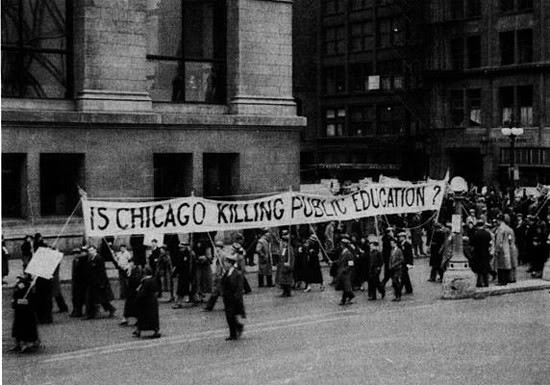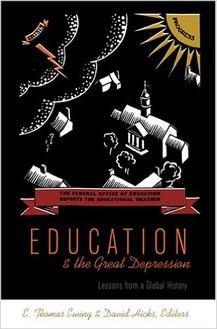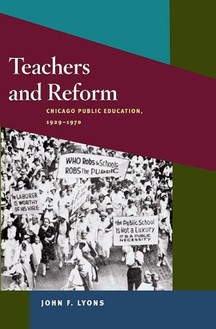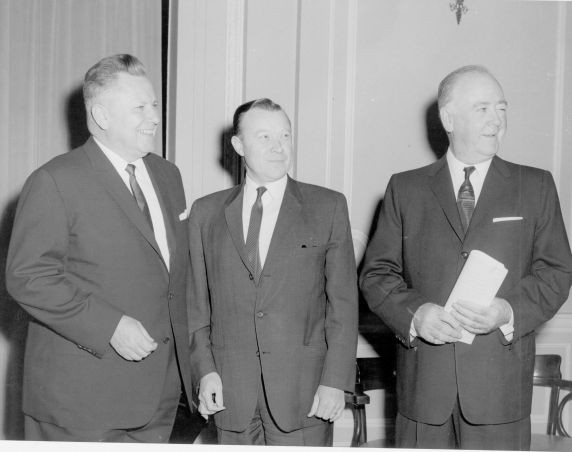Chicago Teachers Strike of 1933
Introduction
Text-to-speech Audio
Images
Chicago Teachers met in Grant Park before leading protest marches throughout the Loop, protesting pay cuts and the city's failure to pay teachers. By the time of this protest in March, 1933, many teachers were owed six-eight months of pay.

Signs with slogans such as "Cash for Teachers" reflected anger at being paid in special scrip that was backed by future tax receipts while other city workers were paid in cash-currency that was backed by gold at that time.

To learn how the Great Depression affected teachers throughout the world, please read Education and the Great Depression: Lessons from a Global History. Click the link below to learn more about this book.

John F. Lyons, Teachers and Reform: Chicago Public Education, 1929-70. Click the link below to learn more about this book.

John Fewkes (pictured on the left) with Walter Reuther, President of the United Auto Workers. The man on the right is William A. Lee, President of the Chicago Federation of Labor.

Backstory and Context
Text-to-speech Audio
The cuts were even larger in Chicago, where the average teacher saw their pay reduced by almost 25%. Making matters worse, the teachers were paid not with cash, but with special notes printed by the city that were redeemable when businesses paid their share of taxes. In an era when US currency was backed by gold, these tax-anticipation warrants were less valued and banks would not redeem them for their full face value. All of that seemed even less important to many teachers throughout Chicago when the Board simply failed to issue paychecks at all throughout many of the months between 1931 and 1933.
By 1933, the average teacher in Chicago was owed six months of back pay. Frustrated by the failure of their union leaders to secure relief, many Chicago teachers built their own organizations and elected leaders who were willing to take to the streets in protest. The Volunteer Emergency Committee (VEC) led by 32-year old gym teacher John M. Fewkes became the most significant of these ad hoc organizations. Fewkes and other members of the VEC recognized that businesses throughout the city were still earning profits but responding to the chaos of the Great Depression by hoarding money and refusing to pay taxes. While the police and other public employees continued to be paid each week, Fewkes asked, why was the Board of Education unable to pay teachers?
Fewkes and other teachers led protest marches throughout the spring of 1933. As awareness of their situation spread, these marches grew to include parents and school children. For the VEC and others, the problem required city leaders to be more aggressive in collecting taxes. In the meantime, they believed, the problem of back-pay might be solved if banks would agree to purchase tax anticipation warrants from the city.
Reflecting their love of education, many teachers were reluctant to join a strike that would hurt their students. Even the simple act of joining a protest march on a day when school was not in session was a radical notion for many teachers, who subscribed to the contemporary notion that teachers should maintain a sense of decorum. As the situation worsened and more of their fellow teachers joined the protests, however, teachers like Mary Winifred Cary decided that it was time to "cast aside the cloak of super sensitiveness and mock modesty, and march forward in the army of the mistreated."
When the teacher's week of spring vacation began on Monday April 24th, five thousand teachers gathered here in Grant Park for a rally and march. Organizing themselves into five separate groups, the teachers marched on downtown banks that had refused to buy tax warrants. Not content to merely protest outside of the banks, as they had done in the past, hundreds of teachers physically occupied the downtown banks until the police physically removed them from the premises. Two days later, several thousand teachers occupied and severely damaged the interior lobby of the Chicago Title and Trust. This violence against property quickly escalated to violence against people, as police clubbed protesters--many of whom fought back by throwing lobby items at the police. The situation looked dire on Saturday May 13, then 15,000 teachers assembled here at Grant Park. Recognizing that many of the protesters were ready to commit vandalism in hopes of forcing city leaders to address their concerns, Fewkes addressed the crowd. Referring to an agreement to pay the teachers, a plan that had not yet been funded, Fewkes assured the crowd that they would soon receive full payment in cash.
Although many of Chicago's teachers would not receive full payment for another year, Fewkes and other teachers were able to prevent most of the protesters from committing acts of violence against banks and other institutions throughout the 1933 and 1934. When the leading teacher's unions of the city merged in 1937 to become the Chicago Teacher's Union, the former gym teacher became the organization's president. Fewkes would later become the leader of the American Federation of Teachers.
